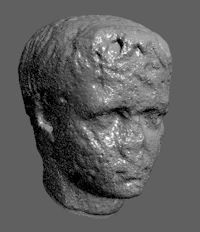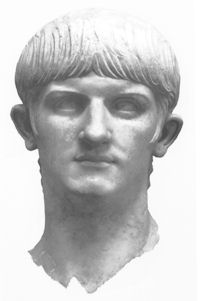
Figure 7: The Hinckley head (Authors' photo, courtesy of Leicester Museum)
The Hinckley head (Figure 7), currently on display in the Jewry Wall Museum, Leicester, is, like the example recorded from Great Eastern Street, London, also in a very poor condition. Discovered in January 1930, within 'a heap of rubbish' at the boundary of Hinckley Grammar School playing field (Pickering 1934, 185) the artefact, made from oolitic limestone, is of uncertain origin. The portrait itself has suffered considerably in antiquity; the head has been broken across the neck, the bust being found as a separate piece.
Limited archaeological examination of the rubbish deposit from which it allegedly derived indicated that some, at least, of the brick and tile recovered here came from the 'demolition of some old cottages' (Pickering 1934, 186). A precise description of this material assemblage is unfortunately lacking, although Pickering observed that the heap also contained 'a fragment of Roman jar and a piece of wall plaster', suggesting that some, at least, of the structural remains found ultimately derived from a Roman source.

Figure 8: 3D scan of the Hinckley head, excluding the shoulders and base (Bournemouth University). 3D PDF | WRL (VRML plugin required)
The life-size head measures 16.2cm in width and is 20.2cm high (excluding the neck). The portrait is of a young, adolescent male (Figure 8) with deep-set eyes and mouth. Unfortunately the nose, eyes and mouth have all been extensively mutilated, although enough survives to indicate the major physiognomic features. The coiffure, which survives extremely well, is distinctly Julio-Claudian with thick, well-defined, comma-shaped locks cascading down the neck and behind the ears. Sideburns are faintly visible on the 3D scan, especially on the slightly better preserved right side of the face, flicking out over both ears towards the eyes. The fringe, although damaged, suggests the presence of elongated curling locks and a triangular central parting.
The flat-base of the bust has a single dowel hole which, together with the projecting, vertically planned shoulders, suggests that the piece may originally have been fitted either as a herm to a plinth or squared column (Toynbee 1964, 48; Huskinson 1994, 13) or more directly to the base of an alcove (Pickering 1934, 185). The combination of material used for the portrait (oolitic limestone) and the overall style of the piece, almost certainly indicate that the head was produced within Britain, rather than representing an expensive foreign import.
The surface of the head is very badly weathered, with significant further damage notable to the face, a variety of discrete, roughly circular indentations visible on the scan across the cheeks, nose, eyes, brow, temples and forehead. These marks are clearly not related to the fossiliferous content of the limestone, being concentrated solely across the frontal area of the portrait. The indentations, which vary in size between 7.2mm and 18.7mm in diameter and up to 5.1mm deep, appear to have been the result of repeated strikes to the face with a small hammer, chisel or blunted pick, at least 62 separate impact fractures being detectable in the scan. Given that the focus for the strikes appears to have been the nose, eyes and mouth, which have been very badly mutilated in the process, rather than simply an attempt to 'roughen' the piece up for alternative building use (in which case the impacts would have continued across all areas of the head), it would appear likely that the damage was the result of a deliberate attempt at disfigurement directed primarily at the sensory organs. Similar 'frenzied' attacks by assailants intent on obliterating identity have been noted in the imperial portraiture of those Roman leaders consigned to post-mortem memory sanctions (damnatio memoriae), such as Nero, Domitian and Geta (Varner 2004, 49-50, 113-14, 276-8).
Toynbee thought the Hinckley portrait was either of an emperor or an emperor's relative, adding that it was probably Britannicus, Claudius' biological heir, as the face 'is younger than that of Nero as we know it from his earliest coins struck in 54 when he was seventeen' (Toynbee 1964, 48). Since the 1960s, however, additional, albeit frequently partial, portraits of the Emperor Nero have been recovered archaeologically which, when combined with imagery recorded from coinage, indicate that there were four major portrait types created for the fifth emperor, each celebrating an important event in his 14-year reign and the years immediately preceding it.
The earliest portrait type celebrates Nero's formal adoption, in AD 50 when he was thirteen, by his uncle, the Emperor Claudius, while the second marks his later teenage years following his accession to the imperial throne in AD 54. Three of the best-known examples in stone of the young teenage prince are today curated by the Musée du Louvre, Paris (Giroire and Roger 2007, 80-1), the Detroit Institute of Arts (Hiesinger 1975, figs 30-1) and the Museo Nazionale di Antichità in Parma (Hiesinger 1975, 115-17; reproduced here as Figure 13). All three portray a toga-wearing youth with carefully combed, central-parted coiffure and lengthy curling sideburns, smooth, regular face, small rounded chin, almond-shaped eyes, aquiline nose and crisply defined lips (Kleiner 1992, 136; Varner 2004, 48).

Figure 9: Aureus of Nero in his late teens, minted between AD 56-7 (© Trustees of the British Museum)
Portraits of Nero produced at the time of his rise to power in AD 54 (Figure 9), depict an individual who, despite sporting the same centrally parted hairstyle of his youth, has slightly more mature, muscular facial features with more clearly defined cheekbones, nose and chin (Kleiner 1992, 138; Varner 2004, 48). A good example of the 'Accession type', produced around AD 55, is today curated by the Museo Nazionale in Cagliari, Sardinia (Kleiner 1992, 136-8; Varner 2004, 48; reproduced here as Figure 10).

Figure 10: Portrait of Nero from his second major portrait phase of AD 54-9 (© Museo Nazionale, Cagliari)
Although damage to the face of the Hinckley head precludes a definitive correlation with likenesses of Nero derived from his first and second major portrait types (AD 50-9), in all cases, the British piece compares well, especially with regard to the position and shape of the eyes, chin and ears and the nature of the coiffure. Given the slightly more muscular nature of the cheeks and chin, it is perhaps more likely that the portrait belongs to the period immediately following Nero's accession in AD 54.
Internet Archaeology is an open access journal based in the Department of Archaeology, University of York. Except where otherwise noted, content from this work may be used under the terms of the Creative Commons Attribution 3.0 (CC BY) Unported licence, which permits unrestricted use, distribution, and reproduction in any medium, provided that attribution to the author(s), the title of the work, the Internet Archaeology journal and the relevant URL/DOI are given.
Terms and Conditions | Legal Statements | Privacy Policy | Cookies Policy | Citing Internet Archaeology
Internet Archaeology content is preserved for the long term with the Archaeology Data Service. Help sustain and support open access publication by donating to our Open Access Archaeology Fund.
File last updated: Tue Feb 05 2013